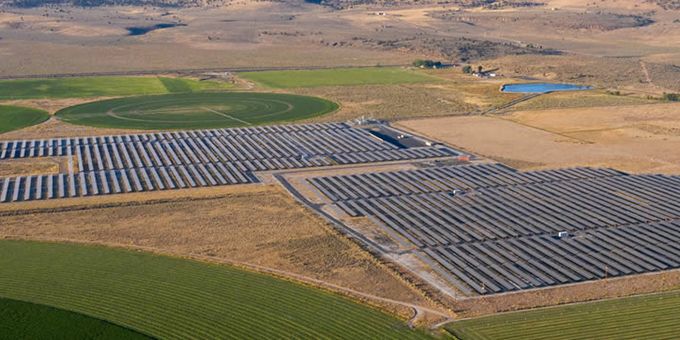LCOE is the metric used by the energy industry to determine how long it will take to pay back the system design and installation and begin turning a profit, similar to the concept of payback in residential and commercial energy systems.
 Optimizing LCOE in Utility-scale Solar Installations
Optimizing LCOE in Utility-scale Solar Installations

Q&A with | Nagendra Cherukupalli, CTO of FTC Solar
Tell us about yourself and FTC Solar.
My name is Nagendra Cherukupalli, and I am currently the Chief Technology Officer (CTO) at FTC Solar. FTC Solar is a provider of solar tracker systems, technology, software, and engineering services. The company’s 2P tracking product, Voyager+, helps utility-scale solar projects achieve higher energy yields and greater power density. At FTC, I am responsible for the Voyager tracker systems that includes structures, controls, and software. I have spent the last twelve years in the renewable energy space as CTO at several companies where I was responsible for introducing several innovative products. With help from various teams, I have helped deliver several hundreds of MWs of solar projects across the world, including the 1km long project on the Narmada Canal in India.
Prior to FTC, I was a Vice President at Cypress Semiconductor, delivering ASICs to the semiconductor market. Prior to Cypress, I managed software design teams at Cadence Design Systems delivering leading Electronic Design Automation (EDA) tools. I started my career at AT&T Bell Labs as a Member of Technical Staff and worked on complex algorithms for the EDA industry.
I am also a Senior Member of the IEEE and hold Master’s and Ph.D. degrees in Computer Science from IIT, Chicago, and am a graduate of the Stanford Executive Program.
What is LCOE and why is it important for utility scale solar installations?
LCOE is the metric used by the energy industry to determine how long it will take to pay back the system design and installation and begin turning a profit, similar to the concept of payback in residential and commercial energy systems. The metric determines energy production needs and if it's viable to build and integrate into the grid, along with how much money needs to be earned per unit of electricity to see a return on investment (ROI).
LCOE is made up of a numerator and denominator to determine the equation. The numerator has two specific contributors: capital expenditures (CAPEX) and operating expenses (OPEX). CAPEX is the budget spent on purchasing the equipment and the labor spent to build the power plant. OPEX is the day-to-day costs incurred to maintain the business operations and the power plant. The numerator, which is the sum of CAPEX and OPEX defines the total cost of the system; the denominator defines the energy production from the site, and the ratio provides LCOE - levelized cost of energy, for that site. By comparing LCOEs for different sites and implementations, we can rank order by effectiveness, which ones are better and which ones are not.
Optimizing LCOE in utility-scale solar installations is imperative to unlock cost savings and ensure plants operate as efficiently as possible.
What role does infrastructure play when lowering LCOE cost?
A form of Infrastructure is used for everything outside the material used to produce energy - like transportation, storage, labor, packaging, recycling, etc. All these have to play a part to make renewable energy possible. This idea is no different when looking at utility-scale solar projects. If you have infrastructure not working correctly, the highest amount of energy will likely not be produced, making the entire system less effective and ultimately affecting the LCOE.
What opportunities are available for the US market if we properly mitigate LCOE?
Many opportunities available within the US market, including total addressable market (TAM) expansion through microgrid development and deployment. In addition, mitigating cyber attacks on energy infrastructure will become increasingly important as energy production will occur near consumption. The growth of energy storage technology to support solar-energy-firming has a role in creating more resilient and robust solutions. Lastly, by mitigating LCOE, we can lower grid maintenance and expansion costs.
How do you use software and learning algorithms to improve yield optimization?
The yield from PV is the denominator in the LCOE equation, meaning the higher the yield, the lower the LCOE. By accounting for ‘as-built variations’, terrain variations, yield can improve. Learning can come into play by accounting for albedo changes that occur seasonally. This includes snow, green grass, and brown land. Learning about these environmental changes at each site impacts yield, especially for bi-facial modules. One way to address this is by ‘managing’ albedo at the site using gravel or reflective sheets laid out on the ground or other organic methods.
How does FTC Solar help developers achieve an optimized LCOE?
The best way to optimize energy yields from the silicon investment is by implementing solar tracking technology, which can increase production by up to 20 percent simply by tracking the sun. And like most evolving technologies today, there are always concerns that need to be addressed, including selecting the best tracker design for the sites.
FTC Solar provides this to developers and uses its innovative zero stow 2P tracker systems to achieve the highest energy yield possible and software that helps developers keep costs down.
The content & opinions in this article are the author’s and do not necessarily represent the views of AltEnergyMag
Comments (0)
This post does not have any comments. Be the first to leave a comment below.
Featured Product

